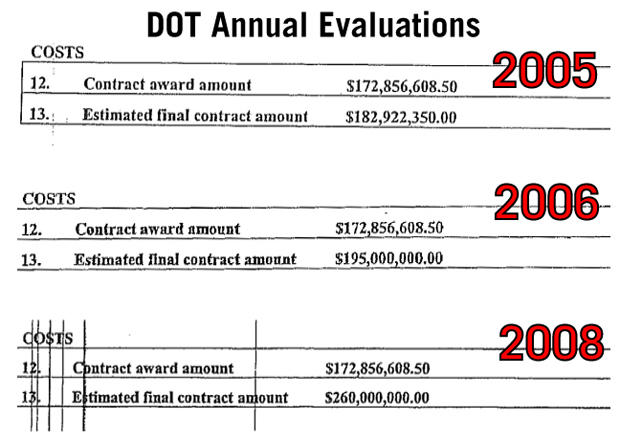One of the main reasons WNYC decided to monitor the renovation of the Brooklyn Bridge is that we thought following this $508-million project would provide a good test case for government transparency. We would publicly mull over questions like How does the city award contracts? Where will the materials come from? Who will get the jobs? Read on, and we'll tell you how the main bridge contractor, Skanska-Koch, got a "marginal" rating for hiring women and minorities. But first...
To get the (paperwork) ball rolling, in January I had a phone conversation with a New York City Department of Transportation spokesperson. My primary aim was to get the contract between the city and Skanska Koch (the winning bidder), but I also wanted supplementary information about how New York made its decision.
By early February, I had not gotten anywhere. So I filed a Freedom of Information Law request with the NYC DOT (in fact, I filed two), requesting the contract, any disclosure statements filed by the winning bidder disclosing past performance, rating sheets reflecting the city’s appraisal of the bidder, and evaluations of Skanska regarding any previous work it has done for the City. (And it's done a lot: $1.4 billion worth of business since 1992, and that's for the NYC DOT alone--I'm excluding from this number their other area projects, like the tunneling for the Second Avenue Subway and the Number 7 train extension.)
In the meantime, we did get some documentation--from the New York City Comptroller’s office, which gave one of our reporters the request for proposals, the document detailing the scope of work that bidders use to price the job.
We began hearing from the NYC DOT soon after filing the FOIL requests – but only to acknowledge their office was working on it. First letter: “You will be notified with the results of the search within 20 business days from the date of this letter.” Then: “This is a follow up to our previous letter dated 03/01/2010. We are still in the process of gathering and reviewing responsive documents and expect to provide you with a response in approximately 60 business days.” And then, dated June 2: “This is a follow up to our previous letter dated 03/01/2010. We are still in the process of gathering and reviewing responsible documents and expect to provide you with a response in approximately 20 business days.” That would mean June 30.
On June 23, I received the first piece of information in response to one of our FOIL requests.
There were annual evaluations by the NYC DOT covering Skanska's rehabilitation of the Williamsburg Bridge --curiously, the years covered are 2005, 2006, and 2008, there's no mention of 2007 -- as well as annual reviews of their work on the Manhattan Bridge's north span (same years, no 2007) and evaluations of Skanska's Manhattan Bridge's lower roadway (covering 2006 and 2008--at this point you have to wonder what happened in 2007).
The annual evaluations follow the same format -- they're prepared by NYC DOT engineers, and they cover 51 questions -- which sounds like a lot, but the format mostly involves checking off boxes, using a rating system that spans from excellent to unsatisfactory, and each evaluation is a compact four pages.
Also included were evaluations from the Mayor’s Office of Contract Services, the city agency that oversees contract compliance. There's one for Skanska's work on the Williamsburg Bridge, and another for their work on the Manhattan Bridge's lower roadway. (Nothing for the Manhattan Bridge's north spans.)
The good: The NYC DOT said that "Koch Skanska did an outstanding job replacing the entire lower roadway (on the Manhattan Bridge) and having it ready to reopen to traffic on October 1, 2007 within 12 months of closure." For the lower roadway work, they were rated as "excellent" in eight separate categories, including quality of contractor's work, quality of supervisory personnal, and compliance with required testing.
The questionable: The DOT gave Skanska a “marginal” rating on their 2005 Williamsburg Bridge annual review in the category of “fulfillment of locally-based, woman-Business, Disadvantaged-Business” because “the contractor has not met the goals established by the contract.” In two later reviews they were upgraded to “satisfactory;” no explanation was given. On the Manhattan Bridge performance evaluations, Skanska was consistently rated “satisfactory” in this area.
On the Williamsburg Bridge, the costs were continually adjusted upwards (and they earned a rare "marginal" rating in terms of "reasonableness in estimating and negotiating change orders."). You can see the progression:

In 2005, the contract award amount was $172,856,608.50, and the estimated final contract amount was $182,922,350. In 2006 the estimate was $195,000,000, and in 2008 the final amount had climbed to $260,000,000. It's interesting to note that the NYC DOT is sticking with the $173 million figure that's on their website; despite their evaluations and the Mayor's Office of Contract Services award number, which is $253,579,812.)
The costs for the Manhattan Bridge work hew more closely to their original estimates. The north spans contract award amount was originally $175,381,645.50; in 2005 it was estimated to be $184,000,000. The lower roadway renovation was initially bid out at $148,301,045.46, it was estimated to end up costing $150,000,000.
We asked Skanska Koch about the Williamsburg Bridge costs, as well as their minority contractor efforts, and they told us that their contract with the NYC DOT prohibits them from speaking to the press. So we reached out to the NYC DOT spokesperson; we're waiting to hear back.
We're still digesting the information that we received -- and looking forward to the rest of it. What do you notice? Does anything stand out for you? Take a look at the evaluations here and comment below (or email brooklynbridge@wnyc.org).
We're still waiting on the contract.